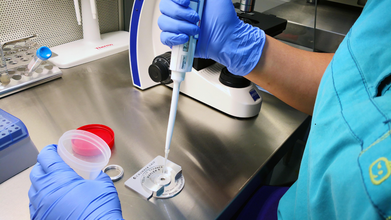- Health Conditions A-Z
- Health & Wellness
- Nutrition
- Fitness
- Health News
- Ayurveda
- Videos
- Medicine A-Z
- Parenting
- Web Stories
Delhi Air Pollution Now Impacting Babies' Respiratory System As They Spend More Time In The Nursery, According To Doctor

Credits: Canva
Since October 19, the PM2.5 levels, which is one of the key pollutants, in Delhi has hovered well above 120 micrograms, while even crossing 200 a couple of times. While the World Health Organization (WHO) guidelines recommend the average PM2.5 levels to be at 15 micrograms per day, reported Healthy Policy Watch. In June 2023, when New York hit PM2.5 levels of 117 micrograms, advisories were issued to shut down schools, for people to remain indoors, and to wear masks. However, there have been no such advisory in Delhi so far.
The data on Delhi pollution has been unreliable, several media outlets have reported the discrepancy between the official data and the on ground data. Many videos online have also shown the gap between these data where people are using their private AQI machines to measure the air quality. Furthermore, a video from opposition legislator Saurabh Bharadwaj that showed water being sprinkled around a government-run air monitoring station in the city on Diwali night have also raised questions on whether the data was tampered.
Amid all this, while doctors have time and again have asked everyone to stay safe, wear mask, and avoid going out during peak hours, studies too have shown fatal links with worsening air pollution. Now, there is an increased risk for infants too. Dr Anjana Singh, director and head of Obstetrics and Gynaecology at Fortis, Noida, as told to the Indian Express said, "Nowadays each newborn is spending a longer time in the nursery before they can be discharged because they are born with respiratory problems and their lung function needs to be stabilised. Some of them have delayed lung development and congenital asthma later. More and more babies are being born with jaundice."
Pollution And Infant Health
The doctor points out that pollution has a deep impact on fetal development than one may think. "It is the reason why we are seeing many more cases of miscarriage, pre-term births, stillbirths, birth defects, congenital heart disease and neural tube defects (the brain and spine do not develop properly)," the doctor explains.
Toxic particles can cross the placenta, the temporary organ that links a baby to the mother through the umbilical cord, and disrupt normal development. They trigger inflammation in the placenta, which creates resistance to blood flow. Over time, the blood vessels become damaged, reducing the amount of blood reaching the fetus.
Air pollution can mess with how nutrients reach the baby, which often leads to low birth weight. Research also shows that when a pregnant woman is exposed to polluted air, the risk of stillbirth goes up, especially in the third trimester.
High levels of fine particulate matter (PM2.5) are linked to low birth weight and premature birth, both of which can cause other health problems. Tiny sooty particles can move through the mother’s bloodstream to the placenta and affect the baby’s lung development, raising the risk of lifelong breathing issues like asthma.
Pollutants such as nitrogen dioxide and PAHs which come from things like burning food, coal, oil or gas can disrupt how organs form. This can increase the chances of conditions like congenital heart defects, neural tube problems or cleft palate. Some studies also suggest that heavy exposure to air pollution during pregnancy may raise the risk of autism spectrum disorder.
Air pollution can also push the mother’s blood pressure up, increasing the risk of preeclampsia, which is dangerous for both mom and baby.
Microplastics in the air come from synthetic clothes, car tires and broken down plastic waste. They act as endocrine disruptors, meaning they can interfere with hormones during key stages of development. They’ve been linked to gestational diabetes, inflammation and gut microbiome imbalance. Microplastics have even been found in the placenta, umbilical cord and cord blood, showing they can reach the baby and interfere with organ and nervous system development.
Children Aren't Distracted By Nature, It's In Their Biology: Research Shows Why Their Attention Span Is Less

(Credit-Canva)
Children are known for hopping from one activity to the next, often when they should be focusing on just one thing. This is a common experience for parents and teachers. A new study suggests that this behavior is not just because kids are naturally curious. Instead, the real reason has a lot to do with the way their younger brains are still growing and working.
Children have a characteristic less attention span, and many people believe that it is simply because the children don’t find it interesting enough, however the study proved that this is not true. Published in the Journal of Experimental Psychology: General, researchers discovered that children's ability to stay focused on one task is limited because their working memory is not yet fully developed.
Why Do Children Have Less Attention Span?
Working memory is like the brain’s temporary notepad, it holds information needed to complete a task. When this memory gets overloaded, children can't stay "locked in" on a single job.
Researchers at Ohio State University essentially forced adults to behave like young kids during a task. They found that when an adult's working memory was filled up, their attention scattered, and they started acting just like young children.
To create the "kid-like" condition, some of the adults were asked to do a second, very difficult task at the same time as playing the candy game. This second task required them to intensely focus on a screen full of numbers and immediately shout out whenever they saw two odd numbers appear right after each other.
This extra mental effort, or load, completely soaked up their working memory, making it much harder for them to stay focused on finding the best candy character.
How Do People Concentrate?
The study included 40 five-year-olds and 71 adults who played a computer game. In the game, participants collected virtual candy from four cartoon characters. Each character always gave a different, fixed amount of candy (1, 2, 3, or 10). The goal was to figure out which character gave the biggest reward.
Some of the adults were given a second, demanding task to do at the same time: they had to watch numbers streaming by and call out when two odd numbers appeared in a row. This extra mental load made it much harder for them to focus on the candy game.
What Causes Scattered Attention In Kids?
Everyone, including the children and the distracted adults, was able to figure out which character gave the largest candy reward. However, the adults whose memory was overloaded, just like the young children, kept switching between characters instead of sticking to the best choice.
Researchers explained noted that this scattered attention happened even when participants knew the correct answer. The finding suggests that what we see as simple distraction in kids might actually come from a brain that is still developing.
The results change how we should view a child's attention span. They suggest that a child's natural tendency to switch focus might actually be a good thing, helping them learn in ways that are more flexible and adaptable than adults. It's not a weakness. This vital research could help teachers and parents create new teaching methods that work with a young child's natural way of learning, instead of always trying to make them concentrate against their developing brain's natural tendencies.
Fact Check: Semen Production Means You Have Healthy Sperms, Here's What The Doctor Says

Credits: Canva
Men's health is a topic often not talked about, however, it is as important as any other health related topics that are addressed more frequently. This is the case especially when it comes to men's reproductive health. While there has a been a lot of studies around semen production and what makes a sperm healthy, there are still many myths around it.
To burst one of such myths, we spoke to Dr Beena Muktesh, Senior IVF Expert at Motherhood Hospital, Gurugram. We asked her whether there was any truth in the claim that semen production is linked to healthy sperm.
Dr Muktesh points out that while sperm-related problems are rampant in men, many men still assume that producing semen automatically indicates fertility. "However, it is a myth that needs to be addressed." She says that there is a need to understand the difference between the two.
What Is Semen? How Does It Tell Whether The Sperm Is Healthy?
Semen is a fluid that is released during ejaculation. It contains sperm and other substances from the male reproductive organs. The sperm is around 1 to 5% of the semen. The rest of it is a liquid called seminal plasma, this includes water, proteins, enzymes, and nutrients like fructose for energy. It Is important for reproduction by helping sperm reach and fertilize the egg. "Healthy semen is pivotal when it comes to male fertility. However, a common myth among men is that if they ejaculate normally, their sperm must be healthy and fertile," she points out.
The doctor says that while semen production is sign that the reproductive system is functioning, it may not guarantee that the sperm it contains are capable of fertilizing an eff.
Dr Muktesh says, "Fertility depends not just on the presence of sperm but on their count, motility or movement, and morphology, or shape. Though many women do not know about this fact and continue to struggle in silence."
Semen that appears normal is volume, color and consistency, could still contain sperm that are low in number. They could move poorly, or have structural abnormalities, pointed out the doctor. "These factors impact the ability of sperm to reach and fertilize an egg, making conception difficult even if ejaculation occurs regularly."
The doctor suggests that men must undergo a semen analysis to evaluate their fertility. The analysis will be able to tell the number of sperm in a given volume of semen.
"Low count can reduce the chances of fertilization. The sperm motility will be checked to know how the sperm will move. Poor motility means sperm may struggle to reach the egg. The expert will also pay attention to the sperm shape and structure. Abnormal shapes can affect the ability to penetrate and fertilize the egg, and make conception challenging," she points out.
There are also other factors like the semen pH, volume, and white blood cell presence that could be monitored to detect infections or other underlying concerns. This is why it is important to get the analysis done and not just assume, she points out.
"Awareness and early evaluation allow timely intervention, increasing the chances of conception and promoting informed decisions about reproductive health. So, men, consult the expert without any delay and know about your sperm health status for healthy conception," she says.
Why Snatching the Phone May Not Be the Ultimate Parenting Tip for Teens

It’s almost a reflex action now - your teen seems distracted, moody or defiant and the first thing you reach for is their phone. Many parents believe that once the phone is gone, their child will start behaving better, focusing more and feeling calmer. But psychologists say this approach may be oversimplifying a complex emotional landscape.
The Real Issue: Teens Want to Be Understood, Not Controlled
Teenagers today are navigating a world far more layered than the one their parents grew up in. Their phones are not just gadgets, they are extensions of their identity, their social life and even their coping mechanisms. When parents link every behavioural problem to 'too much screen time' teens feel misunderstood and invalidated.
Also Read: Popcorn Brain: Is This Syndrome Behind Your Difficulty Concentrating? Experts Explain
“I am tired of being told that if I stop using my phone, I will feel better. My phone isn’t the problem, it’s how I connect with friends and keep up with what’s happening around me. Why should the rules be different for adults and for us?" says 16-year-old G. Kaur
This sentiment echoes across many teenage households - the need to be heard rather than judged. Their brains are still developing, firing signals of independence and identity formation, which often clash with parental control.
Why Parents React the Way They Do
For many parents, taking away the phone feels like the only available disciplinary tool. “Whenever I feel helpless about my son’s behaviour, my instant reaction is to taunt him about his phone usage or take it away,” admits one mother. “I know it is not right, but I don’t know what else to do. We grew up without phones and turned out fine but today’s kids just can’t seem to focus.”
This response, psychologists say, stems from fear and frustration. The digital world is unfamiliar territory for many parents, and snatching the phone feels like regaining control. But in reality, it often deepens the disconnect between parent and child.
Also Read: What Are Kratom And Kava, The Controversial Ingredients In ‘Feel Free’ Drinks?
What Psychologists Recommend Instead
First and foremost, understand the role of the phone. For teens, phones serve as social lifelines, a place where they explore identity, friendship and belonging. Dismissing that entirely can make them feel isolated. So instead of taking the phone away, have open conversations about how and why they use it.
Next focus on connection, not control. Rather than imposing blanket bans, set boundaries. For instance, agree on screen-free times during meals or before bed but let your teen be part of the decision-making. This gives them a sense of respect and control.
Also, look for the real reason behind behaviour. Irritability, withdrawal or lack of focus may not always be caused by phone use. These could be signs of stress, anxiety or emotional overwhelm.
Model healthy digital habits yourself. Teens mirror adult behaviour. If they see you constantly checking emails or scrolling late at night, they will assume it’s normal.
Keep an open communication. Teens respond better to empathy than authority. Simple statements like “I understand it’s hard to disconnect, even for me sometimes” or “I want to know what’s stressing you out” can make way for honest conversations.
In the end, parents need to understand that phones are not the enemy, disconnection is. When parents focus solely on controlling screen time, they risk missing the deeper emotional needs of their teens. Instead of snatching the phone, try reaching for understanding.
After all, the goal isn’t to raise a child who lives without a phone, it’s to raise one who can live well with it.
© 2024 Bennett, Coleman & Company Limited

